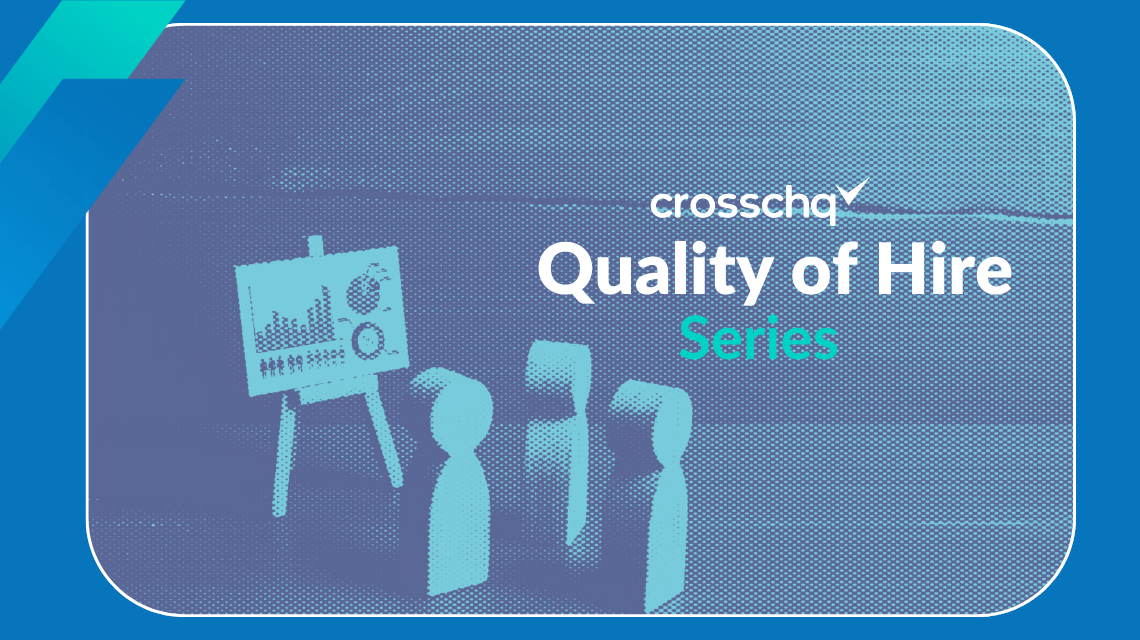

Crosschq Blog
What Is Quality of Hire and Why Does It Matter?

When seeking talent for your organization, it is critical to find employees who will add value to your company in the long term. While the traditional interview and background check offer some insight into individual applicants, it is still all too easy to select the wrong talent for your company. This can result in an ongoing cycle of short-term hires who either resign or are terminated, leaving you with an urgent need to fill positions on a regular basis. Not only is it time-consuming, but hiring a new employee is also expensive. In fact, the cost of hiring a new employee can easily reach thousands of dollars within the first few months.
Thanks to modern technology, hiring managers and recruiters are gaining a more accurate snapshot of the key performance indicators (KPIs) that can predict a quality candidate. Quality of hire is one of the most critical KPI metrics for recruiting and selecting ideal candidates for each position.
What does Quality of Hire mean?
Quality of hire is the value that a new employee contributes to the overall success of your company in the long term. Considering the cost of hiring and training a new employee, it is no surprise that identifying quality hires is increasingly a priority for recruitment strategies. What is surprising is that so few companies use these metrics to determine whether their employees are creating value.
Employers' hesitance to use new hire value data in their recruitment and hiring strategies isn't for lack of interest. Most business owners understand the value of a good employee for the success of their company, but employers aren't sure how to establish reliable candidate ranking metrics and translate that information into a successful strategy. This is largely because, unlike cost of hire and time to fill metrics, quality of hire metrics are more unclear, and cannot be measured accurately in the short term.
Fortunately, a range of data-driven platforms like Crosschq are engineered to simplify your hiring process and improve your quality hires through detailed digital reference checks, dynamic recruitment, and improved data analytics.
What are Quality of Hire Metrics?
According to LinkedIn, quality of hire metrics are one of the top five hiring metrics companies should be using to capture top talent in 2021. These metrics refer specifically to the quantifiable aspects of recruitment and hiring that reflect the value of employees to the company in the long term.
The most common quality of hire metrics include:
- Employee Performance
- Hiring Manager Satisfaction
- New Hire Fit
Although ranking hires relies heavily on employee performance, hiring manager satisfaction, and new hire fit, there are a number of other quality metrics that may be taken into consideration.
- Candidate Pool Size
- Interview Structure
- Reference Quality
- Time to Fill
- Time to Productivity
- New Hire Goal Establishment
- Job Performance and Management
- Employee Engagement
- Cultural Fit
- Employee Retention
By tailoring these Quality of Hire measures to target the particular needs of your operation and the role in question, you can ensure that you have the most complete and accurate information needed to hire the most suitable applicants and retain key employees. The first step is to create a quality of hire index, as a reference point from which to calculate your success in improving quality hires.
How Do You Calculate Quality of Hire?
Calculating the quality of hire of an individual during the hiring and training process is different from calculating it for your organization as a whole. However, both individual and company values are linked and offer unique and necessary insights for improving your hiring and recruitment strategies.
The fundamental calculation is:
 How to measure employee performance
How to measure employee performance
The value for employee performance can be calculated using several factors, including:
- Job Performance
- Employee Engagement
- Time to Productivity
- Cultural Fit
By calculating the average of all factors on a constant rating scale, say 1 to 10, you can reliably measure the quality of individual new hires and their performance. You can also calculate the average of these scores among all of your new employees to establish your overall quality value for new hires.
How to measure hiring manager satisfaction
While it can be tempting to focus on the individual new hires, your hiring manager's satisfaction plays a critical role in your company's quality of hire. Using periodic internal surveys, you can garner valuable information about the recruitment and hiring process. With a tailored hiring manager satisfaction survey, you can gauge:
- General satisfaction with hiring processes
- Overall candidate quality
- Recruiter success with engagement and promotion
- Quality and timeliness of communication
- Manager's understanding of their role within the organization
This information is crucial to ensure continuous improvement of your recruitment process.
How to measure new hire fit
Choosing the right person for your organization is more than just measuring their performance, it is ensuring that they fit into the company seamlessly. When determining your new hire's fit within the company, consider the following:
- Employee's understanding of their role
- Dedication to company values
- Engagement with position, co-workers, and the organization as a whole
- Compatibility with the company culture
Measuring overall Quality of Hire for the recruitment process
Using individual scores from your new hires, hiring manager satisfaction surveys, and employee retention numbers, you can calculate the overall success of your recruitment process. By parsing the information based on recruitment tactics or specific timeframes, you can calculate the quality of hire for specific recruitment methods. In short, real-time data, such as what Crosschq can provide, for employee performance, retention, and manager satisfaction allows you to continuously refine your recruitment process and improve your quality hires.
What are Quality of Hire Benchmarks?
These benchmarks refer to the ratings systems and indexes you put in place to evaluate your new hires. These benchmarks can include everything from employee goals and performance to manager satisfaction and company culture.
When this performance data is taken from multiple employees over the course of several months or years, you gain a more complete picture of the recruitment process. This quantified data allows you to adjust your recruitment and hiring strategies to reduce turnover, enhance employee engagement, and ultimately hire and retain the right talent for each position.
With a focus on quality hires, your organization is more likely to recruit top performers who will contribute significantly more to your company's overall productivity. By tracking the performance and contributions of your new hires, you can see which employees become top performers and tailor your recruitment accordingly.
 How Do You Improve Quality of Hire?
How Do You Improve Quality of Hire?
Making improvements is a long-term goal that can take months or even years. Unlike more traditional hiring processes that focus on resumes and interviews, Quality of Hire processes focuses on improving your overall recruitment and hiring strategy. Ultimately, the goal is to ensure that the employees you hire are creating more value for the organization than they are earning. This means collecting both pre-hire and post-hire data, keeping your hiring workflow organized, and establishing common goals for your hiring managers.
Pre-hire and post-hire data collection
Your recruitment strategy should incorporate pre-hire data such as:
- Job Skill Tests
- Resume Screening Scores
- Interview Test
- Reference Scores
Post-hire data is equally critical and includes:
- Manager Satisfaction
- Employee Self-Ratings
- Productivity Numbers
- Length of Tenure
Organizing hiring and recruitment workflow
Workload organization for your recruiters and hiring managers can help to streamline the process and enhance the productivity and efficiency of your recruitment activities. A streamlined workflow allows for quicker candidate selection by:
- Enhancing screening processes using automated technology like Crosschq 360
- Analyzing candidate conversion data for areas of improvement
- Establishing flexible strategies that utilize resources where they are needed
- Creating templates and automated processes for repetitive tasks
Establishing common goals
Improving your quality of hire means having all of your hiring managers on the same page when it comes to hiring and recruitment goals. Communication is key to establishing common goals, which in turn allow you to streamline operations for a faster, more efficient hiring process. Keep your hiring managers aligned with:
- Clearly defined terms and goals
- Consistent metrics and benchmark rankings
- Established best practices for interviews and employee assessments
Partner with Crosschq to Enhance Your Quality of Hire
From pre-hire to post-hire improve and measure your quality of hire with Crosschq. Crosschq 360 talent acquisition software, Recruit candidate referral network, and data-driven Analytics will all help you establish a winning recruitment strategy.
To learn more about Crosschq, contact us to schedule a personalized demo.
Newsletter Sign Up

by Chris Drake
Crosschq, Head of Data
File Under
Take the Guesswork
Out of Hiring
Schedule a demo now



%20-200x43.png)






